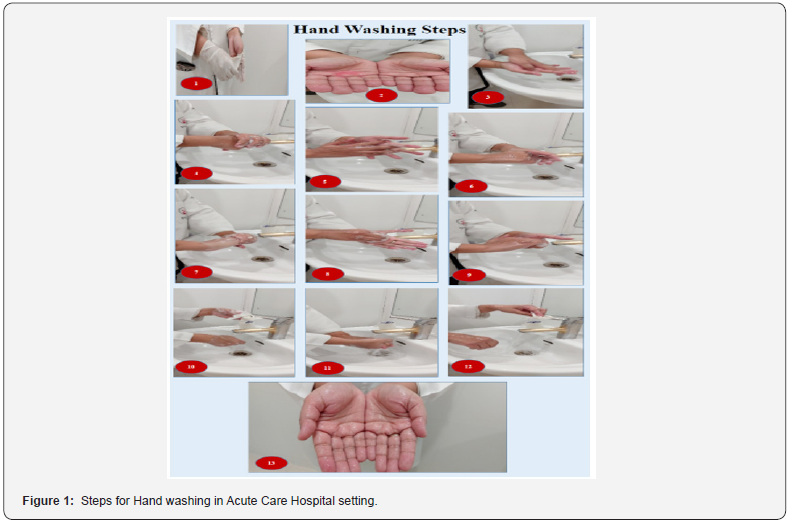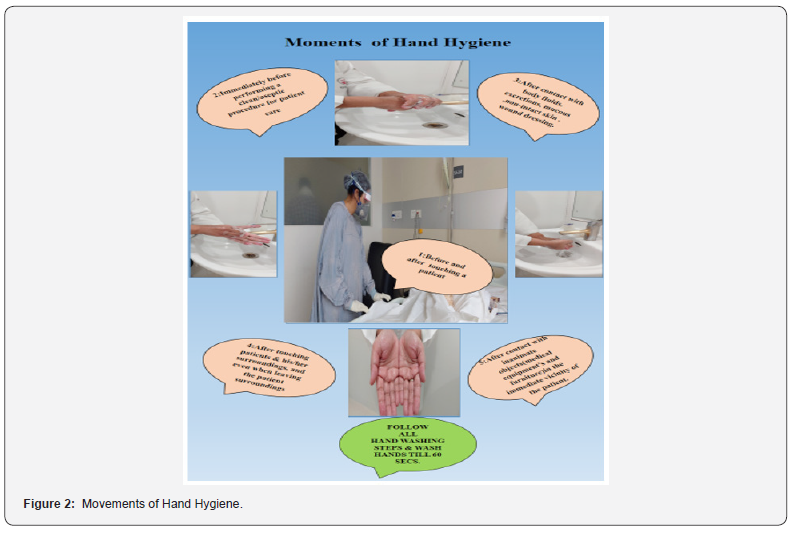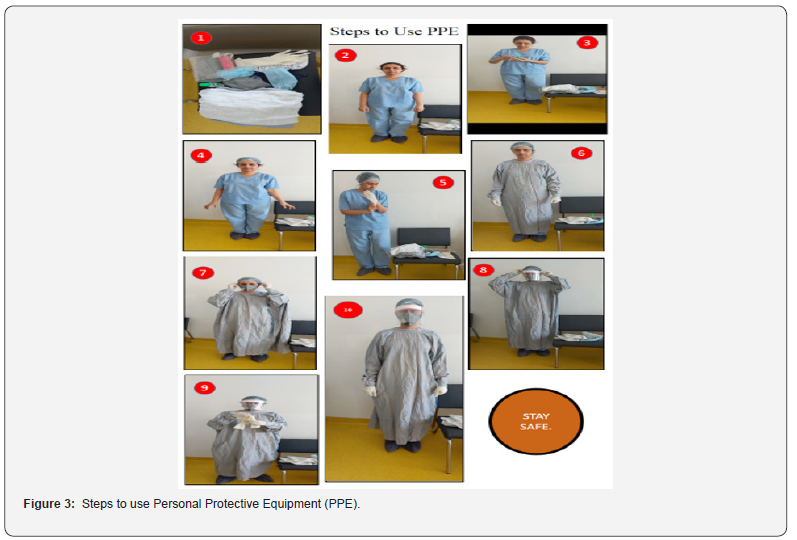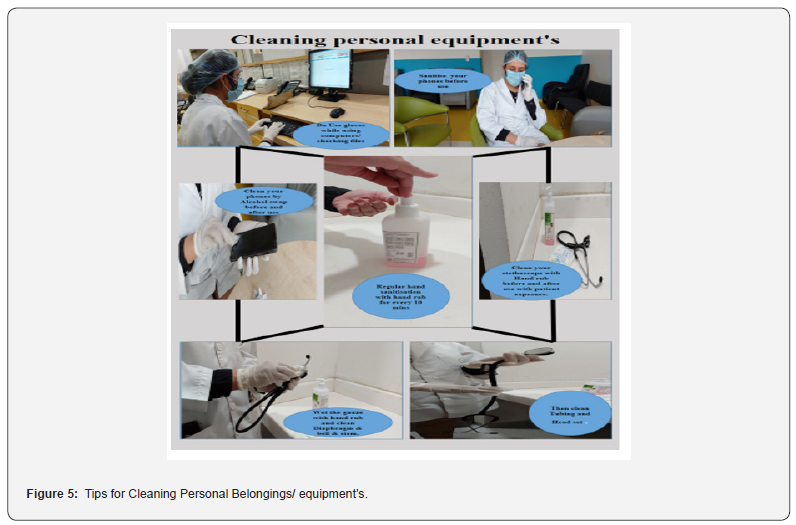Infection Control Process and Standard Precautions for Speech Language Pathologist at Acute Care Hospitals in COVID -19 Pandemic
K Govathi Nikhila*
Dysphagia-Speech Specialist, Institute of Head and Neck Oncology, India
Submission:May 11, 2020; Published: June 01, 2020
*Corresponding author:June 01, 2020
How to cite this article: K Govathi N. Infection Control Process and Standard Precautions for Speech Language Pathologist at Acute Care Hospitals in COVID -19 Pandemic. Glob J Oto, 2020; 22(3): 556089. DOI: 10.19080/GJO.2020.22.556089
Keywords:Surveillance; PPE-Gloves; gowns; Masks; Eye protection; Hand Hygiene; Alcohol hand rub; clostridium; N95 mask; Dysphagia evaluation
Introduction
Infection control process
Surveillance is one of the most important components of an effective infection control. Effective infection prevention and control is central to providing high quality health care for patients and safe work environment for those that work in health care settings. It is important to minimize the risk of spread of infection to patients and staff in hospital by implementing good infection control programme [1]. This is the first edition of infection control and standard precautions for use of speech language pathologist(SLP’S) to follow at their Acute care Hospital settings during this COVID-19 Pandemic.
Preventing infection in healthcare facilities
(World Health OrganizationWHO-2020 Module-4)
a. Distancing/separation/restriction of movement and of visitors
b. PPE-Gloves, gowns, masks, eye protection (where appropriate)
c. Hand Hygiene
d. Cleaning. Disinfection and sterilization
e. Waste management.
f. Staff health management
g. Discharge of Patients
h. Care of the deceased
As a Speech Language pathologist if we think about our role and responsibilities in handling the patient in terms of Speech, Language and Dysphagia related issues, it is difficult to manage in these current crises. Still as Health care professionals, we are working for the patients better met at the same time our safety and health management is important. By keeping in mind about our field and its responsibilities and commitment towards the patients and our health, through this article I am aiming to show you all some of the standard safety precautions which we need to follow whenever we are seeing a patient in Acute care Hospital in this COVID-19 Pandemic. So that we all can stay safe and keep others safe.
Standard precautions
The concept of standard precautions was first introduced as universal precautions in 1985 with the emergence of HIV/AIDS. The Centers for disease control and prevention’s (CDC’S) introduced the term standard precautions in 1996 with the view that all patients are infectious regardless of suspected or confirmed infection (Siegel et.al 2017). In 2017, additional elements were added to standard precautions to protect patients during health care delivery [2]. Now during this COVID-19 Pandemic period, World Health Organization was come up with the first edition of infection control and prevention during health care services [3]. By considering, all this made me interest to write up this article tohelp the Speech language pathologist (SLP’S) who are working in acute care Hospital settings.
Standard precautions include Hand hygiene
It is single most important infection prevention control (IPC) Precautions and one of the most effective means to prevent transmission of pathogens with in healthcare services. Hand hygiene is a general term that includes handwashing, antiseptic hand rub and surgical hand antisepsis.
Methods for Hand Hygiene:
a. Alcohol hand rub(minimum 60% alcohol)
b. Soap and Water
c. Surgical hand Hygiene(either alcohol rub or antimicrobial detergent)
Hand washing with soap and water
When hands are visibly soiled or patient has clostridium, difficile infection do wash your hands with soap and water for 60 secs. Water should be clean and bar soap is acceptable. Let us follow all hand washing steps before seeing the patient and after seeing the patient.
Steps for hand washing in acute care hospital setting
a. Remove the gloves and discard it in waste bucket.
b. Take equal amount of soap into your hands.
c. Now, rub your hands from palm to palm.
d. Now rub your hands from Palm to Dorsum vice versa.
e. Now rub through interlaced fingers and vice versa.
f. Rotational rubbing of left thumb clasped in right palm and vice versa.
g. Rubbing from Palm to Dorsum & vice versa.
h. up right palm with left fingers in rotation & vice versa.
i. Interlocking the Fingers & vice versa.
j. Turn ON the Tap with Tissue paper.
k. Rinse your hands with water
l. Turn OFF the tap with tissue.
m. Now Your Hands are safe and free from germs (Figure 1).

Movements of hand hygiene
As we all know there are 5 movements of hand Hygiene but apart from those an additional hand hygiene movements were explained here based on the our working environment at acute care hospitals .where we all need to follow all these movements of hand hygiene , as it is a most important step in control of hospital acquired infections. The moments of hand Hygiene are as follows:
Before touching the patient & after touching the patient.
a) Before a clean/aseptic procedure.
b) After blood/body fluid exposure risk.
c) After touching patients surrounding
d) After contact with inanimate objects (medical equipment’s and furniture) in the immediate vicinity of the patient.
e) Additional Movements of Hand Hygiene are as follows:
f) If moving from contaminated –body site to a clean body site during patient care.
g) Before putting gloves and after removing gloves do wash your hands.
h) Wash your hands before and after touching any files, Computers, Therapeutic materials or any patient materials.
i) Before entering and after leaving into the facility or ward/ ICU.
j) Before and after touching any doors to open in wards, ICU, OPD.
k) Before and after cleaning the environment (ex: table, toys files used during the sessions).
l) Before and after touching your eyes, nose, ears, mouth.
m) Before eating and drinking.
In order to maintain our hand hygiene and clean in current pandemic, we also need to follow certain steps to keep our hands clean and protective such as:
i. Nails should be small, clean and polish free.
ii. No artificial nails/extensions to be used.
iii. Do not wear wristwatches and jewellery, rings.
iv. If you have any cut on your hands, do cover it with water
proff dressing.v. Sleeves should short /rolled up (Figure 2).

Personal Protective Equipment (PPE)
Before knowing anything about PPE Primarily, one should know about its use and importance. In current pandemic, it is being mandatory to everyone to protect themselves and others from infection. However, in current pandemic using of instrumentations for clinical judmentment is also restricted as we are SLP’S mostly deal with the throat examination despite of speech / dysphagia currently we are facing an issue to make the patients to speak or to eat. Here by let us see the following PPE use and tips (Figure 3):

PPE –Kit Should Contain:
a) Scrubs and closed-toe shoes
b) Gloves
c) Gown
d) Apron
e) Respiratory mask-N95
f) Face shield
g) Goggles+ surgical facemask.
How to put on PPE
a. Collect the necessary items from PPE as suitable and accordingly to the environmental condition and patient situation.
b. Then put on the scrub + shoe cover.
c. Sanitise your hands.
d. Tie up your hair and put on the hair cap.
e. Again, sanitise your hands and put on the disposable gloves.
f. Put on the Gown, can take the help of buddy to tie up your gown.
g. Put on the N95 mask.
h. Put on the Face shield/Goggles.
i. Put on the surgical gloves and make sure that it tightly covered and put on gloves over cuff.
How to remove PPE
a. Do not take any help from any one when you are removing the PPE.
b. First, remove the Gown.
c. Remove the gloves
d. Sanitise your hands.
e. Remove the face shield and mask from behind.
f. Sanitise your hands again.
While treating the patient with PPE
a. Make sure that you are well covered.
b. Make sure that patient is also wearing respiratory mask.
c. Do not stand in front of the patient while talking, counselling, or examining.
d. Stand side to the patient with 2meters distance and talk.
e. If patient, cough/sneezes during the session and if mucous spilled on PPE, don’t touch any one and anything, immediately move away from there discard the PPE in closed bin and inform the team about the same.
f. Do not touch your face while you are putting PPE.
Respiratory Hygiene and Cough Etiquette
Respiratory and cough hygiene is designed to minimize the risk of respiratory infections:
a. When sneezing /coughing cover the nose and mouth
with a disposable tissue. Discard immediately into a waste bucket.Do not put the tissue into the pockets.
b. If disposable tissue is not available cough/sneeze into bent elbow.
c. Always face away from others when coughing, sneezing, or just move away.
d. Wash hands immediately after coughing or sneezing.
e. Do not touch anything / eat anything immediately after coughing/ sneezing.
Social distancing at hospital settings
According to the World Health Organisation WHO-2020 Module 4 the social distancing and separating the patients according to the COVID-19 Pandemic was explained. In which generally it says that all respiratory patients need to be separated by identifying the patients with fever, cough, cold, breathlessness and before they enter into the ward other symptom patients need to be separated and also should ensure that they should have separate waiting area and distance between the beds need to be maintained.
Rules of Social Distancing:
a. No hand shakes.
b. Say Namaste.
c. Maintain 6 meter distance from each other.
d. No groups/ gathering.
e. Stay out of crowded places and avoid mass gathering.

However, social distancing is also important to maintain in between the health care professionals who are working at hospital settings in current COVID-19 Pandemic. Sometimes due to any reason, we could not follow the social distancing due to which some time it may affect you and the other person too. In Hospital setups sometimes we do follow the social distance with patient and their caretaker but we miss to maintain or follow the social distancing rules with our colleagues, friends it may affect any other in any way so it is important to maintain the social distance at hospital setting (Figure 4).
Social distancing tips
a. If your collage touches you or comes closer say stop to them, maintain the 6-meter distance, offer them a seat, and then communicate with them.
b. Make sure that you both wear mask while communicating.
c. Do not sit and eat in crowed places like cafeteria, lunch areas.
d. While seeing the patient make sure that you put on all PPE and maintain the 6 meter distance or 2 feet’s distance based on the patient status
e. Do not stand in front of the patient, stand to side.
f. While counselling him caretaker do maintain the social distance and educate them about the same.
g. If any person is standing towards you and talking to you but if you are sitting on chair then immediately stand and maintain the distance.
h. Do not walk with holding hands with your friends or colleagues.
i. Do not travel in left if there are more than 4 members.
j. Do follow the cue line at pharmacies, cafeterias in hospitals.
Note: To watch the Video of “Social Distancing” do watch on “Dysphagia –speech Talk” YouTube channel.
Cleaning Therapeutic Materials / Personal Cleaning Therapeutic Materials / Personal
In current COVID-19 Pandemic Situation, it is not recommended and safe to use any instrumentations for swallow or speech evaluation. We all have different responsibilities and commitments to achieve patient’s goals. In our daily job route, we all need to do documentation, do team working either directly or telephonically, use stethoscope for Dysphagia evaluation, or use some therapeutic materials like (fruit tray, flash cards, blocks, puzzles boards) for patient use. So here, we are going to see some tips to how to keep our personal belongings safe and clean (Figure 5).

Tips for cleaning personal belongings/ equipment’s
a. Wash your hands for every 10-15 minutes.
b. Wear gloves whenever using computer or telephonic conversation.
c. Later discard the gloves and wash your hands.
d. Sanitise your stethoscope before and after patient use.
e. Sanitise your hands again.
f. After talking through phone, clean it with Alcohol swap after every use.
g. Wear gloves and touch the patient files / read the patient files.
h. Make sure that table, door, room and chair are sanitised properly.
i. Make sure that toys, boards used in the session are cleaned with Alcohol rub (only if used, mostly try to avoid using the materials).
j. Keep the door open whenever you are taking OPD, so that no one can touch the door and make sure that room need to sanitise regularly.
Note: To watch the Video of “Cleaning the Equipment/ personal belongings” do watch on “Dysphagia –speech Talk” YouTube channel.
Speech and swallow services in pandemic
a. Due to current Situation apart from COVID-19 patients other patients are facing an issue by not able to attend or receive the speech and swallow services. So currently, we need to focus on Tele Consultation Services.
b. Through this tele-video consultation, we can start with the speech therapy and swallow therapy sessions.
c. Do not take any decision on swallowing and diet upgrading through tele-video consultation if you are not sure.
d. Do stay in touch with regular follow up sessions and provide them a home based management programme.
Document your notes in the applications and share it with them.
References
- Hospital of Infection and control Guidelines.
- National Prevention and Control Gudilines-2015.
- World Health Organization WHO-2020-Module4 “Infection Control and Prevention”.





























